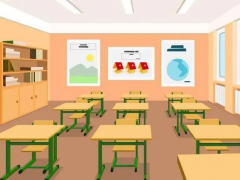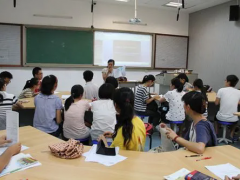小学英语说课稿全英范文
小学英语全英文说课稿
Good morning, everyone! Today, I'll say something about Unit 9 Part A in Book 4 of Oxford English. Background on the reformation of curriculum, this book can connect the life and act, emphasize the interest and experience of the Ss, the pictures are active and vivid. Grade four is the initial stage of English learning, so it stresses on the emotion of the Ss, creates a well beginning for the Ss. This Unit has 7 parts, we'll learn Part A mainly, it embodies the repeating characterize. Review the learned language points “Where's…”and the new language points will be represented in the following units. So this unit forms connecting links with a special meaning in this book. The content of this period is to use “Where'sare…” to determine the place. And according to the contents and the fact of the Ss, I establish the following three teaching aims of this period: The first one: students can listen, read, say and spell the following words: a glass, a fridge, an egg, bread and a table. The second one: students can listen, read, say and write the following daily expressions: What's for breakfast? Have some juice then. The third one: students can listen, read, say and write the following sentence patterns: Where'sWhere are themy… It's They're… There's no …in on near… I think the most difficult point of this period is to make sure the students can use the patterns “Where'sWhere are…and There is no …inonnear…” in their daily life correctly. And I will use some pictures, words and sentence cards, a tape recorder and the multi-media computer to help me achieve the aims. The task-based method, communicated method, group cooperate method will be used in this period. To accomplish the aims, I design the following steps: Step 1 Songs and the game arousers the emotion. In order to attract the Ss' attention and construct an atmosphere of learning English, I let the students sing some English songs and play the game “Simon says”. At the same time the game can review the prep, serve the knowledge as foil and consist the appearance of the knowledge. Step 2 Change class to life, happy to say. The substance of language is communication and the environment of communication is life. So when I present the sentence pattern “What's for breakfast?” I first show a clock to elicit the time for breakfast, teach the sentence. Then show my own photo of having breakfast, Ss ask and guess. In this way I can attract Ss' attention, encourage Ss to ask Qs with the new knowledge. Most of the Ss have learnt the sentence pattern: Where's…? so I design a task for Ss to help Helen find the food and drinks for breakfast, and teach the new language points: Where are…? They're … Meanwhile stick the sentences on the Bb. After some practice by asking and answering, I present the next language points: There's no …inonnear… Have …then. And I will stick these sentence patterns on the Bb. Finally I'll let the Ss do pair works to consolidate them. Step 3 Listen to the tape and Ss imitate to read and say. As the new reformation of curriculum, emphasized the traditional class attach importance to the mechanical teaching, neglect the experience and participation, for example, the five-step method. So in this lesson, after presentation, I ask Ss to listen to the tape with three Qs, read in different roles and in pairs, then try to recite the text. Step 4 Ss be the main body, T makes a guider. In class, Ss play as a host, and the T makes an influence on guiding, help Ss to act the learnt dialogue, it can stress the position of the Ss, and arouse their interest. Then I show a carton with no voice, ask Ss to make a dialogue in pairs. There are lots of ways to consolidate the new knowledge. Playing game is a good way. So according to the physiology of Ss, I hold a group competition during the game, ask Ss to finish the blanks. In this way can develop Ss' good habits and achieve the aim of mastering the learned knowledge in situation. Step 5 Change class to life, learn by themselves. Is this the end of the class? I don't think so. If there is an end, I think it should be in the life. So I extend this class, encourage Ss to use the learned to communicate with each other in their life. In a word, the whole period is based on tasks, which are designed from easy steps to steps that are challenging. When the Ss are carting out the tasks, they can acquire information, knowledge, and have their ability and skills trained. That's all. Thanks a lot for your attention.。
小学英语全英文说课稿
我只知道小学应该这么讲先说Class begins,good morning/afternoon boys and girls.再说Do you know xxx?It's xxx(adj).Open your book and turn to page xxx,today we'll learn something about it/them.然后开始讲课就行了讲课中常用的:Practice in pairs(两人一组练对话)Open your bookClose your bookDo you have any questions?Look at blackboard.Write down some notes(做笔记)Stand up please.Ok,sit down.Listen to me.Let'splay a gameWho wants to have a try?(谁想试一试)最后Now class is over,see you next time.Thank you。
.。
小学英语全英文说课稿
Good morning, everyone! Today, I'll say something about Unit 9 Part A in Book 4 of Oxford English. Background on the reformation of curriculum, this book can connect the life and act, emphasize the interest and experience of the Ss, the pictures are active and vivid. Grade four is the initial stage of English learning, so it stresses on the emotion of the Ss, creates a well beginning for the Ss. This Unit has 7 parts, we'll learn Part A mainly, it embodies the repeating characterize. Review the learned language points “Where's…”and the new language points will be represented in the following units. So this unit forms connecting links with a special meaning in this book. The content of this period is to use “Where'sare…” to determine the place. And according to the contents and the fact of the Ss, I establish the following three teaching aims of this period: The first one: students can listen, read, say and spell the following words: a glass, a fridge, an egg, bread and a table. The second one: students can listen, read, say and write the following daily expressions: What's for breakfast? Have some juice then. The third one: students can listen, read, say and write the following sentence patterns: Where'sWhere are themy… It's They're… There's no …in on near… I think the most difficult point of this period is to make sure the students can use the patterns “Where'sWhere are…and There is no …inonnear…” in their daily life correctly. And I will use some pictures, words and sentence cards, a tape recorder and the multi-media computer to help me achieve the aims. The task-based method, communicated method, group cooperate method will be used in this period. To accomplish the aims, I design the following steps: Step 1 Songs and the game arousers the emotion. In order to attract the Ss' attention and construct an atmosphere of learning English, I let the students sing some English songs and play the game “Simon says”. At the same time the game can review the prep, serve the knowledge as foil and consist the appearance of the knowledge. Step 2 Change class to life, happy to say. The substance of language is communication and the environment of communication is life. So when I present the sentence pattern “What's for breakfast?” I first show a clock to elicit the time for breakfast, teach the sentence. Then show my own photo of having breakfast, Ss ask and guess. In this way I can attract Ss' attention, encourage Ss to ask Qs with the new knowledge. Most of the Ss have learnt the sentence pattern: Where's…? so I design a task for Ss to help Helen find the food and drinks for breakfast, and teach the new language points: Where are…? They're … Meanwhile stick the sentences on the Bb. After some practice by asking and answering, I present the next language points: There's no …inonnear… Have …then. And I will stick these sentence patterns on the Bb. Finally I'll let the Ss do pair works to consolidate them. Step 3 Listen to the tape and Ss imitate to read and say. As the new reformation of curriculum, emphasized the traditional class attach importance to the mechanical teaching, neglect the experience and participation, for example, the five-step method. So in this lesson, after presentation, I ask Ss to listen to the tape with three Qs, read in different roles and in pairs, then try to recite the text. Step 4 Ss be the main body, T makes a guider. In class, Ss play as a host, and the T makes an influence on guiding, help Ss to act the learnt dialogue, it can stress the position of the Ss, and arouse their interest. Then I show a carton with no voice, ask Ss to make a dialogue in pairs. There are lots of ways to consolidate the new knowledge. Playing game is a good way. So according to the physiology of Ss, I hold a group competition during the game, ask Ss to finish the blanks. In this way can develop Ss' good habits and achieve the aim of mastering the learned knowledge in situation. Step 5 Change class to life, learn by themselves. Is this the end of the class? I don't think so. If there is an end, I think it should be in the life. So I extend this class, encourage Ss to use the learned to communicate with each other in their life. In a word, the whole period is based on tasks, which are designed from easy steps to steps that are challenging. When the Ss are carting out the tasks, they can acquire information, knowledge, and have their ability and skills trained. That's all. Thanks a lot for your attention.。
小学英语外研社新标准一起说课稿 越多越好
It's my great honor to be here sharing my lesson with you.The content of my lesson is《New Standard English 》Book4 Module8 Unit1 I was two. Then I'm going to talk about it through the following six aspects: teaching material, students, teaching aims, teaching points, teaching preparation and teaching process.一、Teaching materialThe topic of this module is “Changes”. The language function of this unit is throughing the photos of Lingling's grandparents and her own to describe the things past with “was/were”. The main patterns “They were young.” and “I was two.” are close to Ss' daily life. Therefore, they would show their great interests in this lesson and try to use what they have learnt in their real lives. By studying this unit, Ss can discuss the things that occurred in the past to themselves with “was/were”.二、StudentsThe Ss in grade four have got some English foundations. They also have higher learning enthusiasm and lively personalities. As a result, the activities full of fun and relaxation are offered in order to let the Ss learn English more freely. Meanwhile, the abilities of observing and self-study , the habits of independent thinking and positive participation are fostered in the class.三、Teaching aims(一)Aims on the knowledge1.The Ss can understand and speak the words: who, grandparents, then, me, hair, so.2.The Ss can understand and speak the sentence patterns: They were young. I was two.(二)Aims on the abilities1.The Ss can read the dialogue fluently.2.The Ss can communicate with “was/were” according to the photos.(三)Aims on the emotionThrough the Ss' comparison the old life with the new one, they will not only cherish the life nowadays, but also improve emotion between the families.四、Teaching points(一)Key points1.The Ss can understand and speak the new words and the sentence patterns.2.The Ss can describe the things past with “was/were”.(二)Difficult points1.The Ss know the usage and relationship between “am/is/are” and “was/ were”. 2.The Ss can discuss the real life with the sentence patterns freely and creatively.五、Teaching preparationTape, recorder, photos, multimedia, cards, stickers. 六、Teaching processStep 1 .Warming-up1. Greetings2. Enjoy the song “The family”.3. Free talkT: Here is a family photo. Let's describe it. In this photo, Father is … (choose the appropriate adjectives) S: ….T: Mother/Brother/Sister/Baby is……[Design intent] The song can adjust the Ss' thought, arouse their interest in learning English, let them enter the atmosphere of learning English quickly.The free talk can help them review the adjectives which are used to describe the personalities and characters.Step 2.Presentation1. Leading- inT: Here is another family photo. Do you know who the baby is?S: …T: It's me! ( Teach the word “me” at this moment.) I was two, then. Now I am 30. (Show Ss the current photo.)T: Our friend Lingling has got some photos, too. Do you want to have a look? [Design intent] Through the new and old photos show, bring out the topic of the text smoothly and make a good preparation for the text learning. 2. Text(1)Listen and try to find out the words they don't know. Study them in groups. Then T consolidates the meaning of “who, grandparents, then, hair, so”.(2)Listen read and underline the sentences with “was/were”. T: What's the difference between “am/is/are” and “was/ were”? (Explain it under the help of the photos.)[Design intent] Through the listening and underlining, Ss can have the deeper understanding to the text. Explain the past tense appropriately and design the blackboard writing reasonably. Let Ss know the meaning and usage of “was/ were” clearly.(3)Listen and read the dialogue again.Step 3.Practice1.Look, listen and guess.Show Ss four pairs of pictures, choose the correct one after listening to T's description.2.Do Activity 3 on page 31. Discuss the answers in groups. [Design intent] Through the activities, let Ss practice the sentence patterns step by step. Cultivate Ss' abilities of cooperation and participation by group-working. Step 4 Consolidation1.Enjoy the passage of the cartoon “The ugly duckling”. Discuss the changes of the little duckling according to the T's reminder.2. Show Ss some photos of new and old Yantai, let them realize the great changes of our life.[Design intent] The cartoon can make Ss show more interests in learning English. Through the photos show, Ss will love and cherish the new life more.Step 5 SummaryAsk Ss themselves to summarize what they have learnt today. Step 6 Assignment1.Listen and 。
怎样写小学英语说课稿(全英文的)
本课重点围绕学生对几种体育运动是否喜爱这个题材开展多种教学活动,通过学习句型 I like …I don't like …,让学生能够用英语表达出自己的思想和感受。它是整个模块的重点,占有很重要的地位,它为后两个单元的学习奠定了基础。
2.教学目标
知识目标:学习掌握单词 football. basketball. table tennis. morning exercise,学习运用句型 I like …I don't like …。
能力目标:培养学生运用英语的能力。
德育目标:教育学生热爱体育运动,勤于体育锻炼。
确立教学目标的依据:根据《英语新课程标准》的要求,小学阶段的英语课主要是激发学生学习英语的兴趣;培养学生对英语学习的积极态度,使他们建立学习英语的自信心;培养学生一定的语感和良好的语音、语调,为英语的进一步学习打下基础。
3.教学的重点与难点
教学重点:能听说单词 football. basketball. table tennis. morning exercise,运用句型 I like …I don't like …。
教学难点:灵活运用句型 I like …I don't like …。
确立教学重难点的依据:根据《英语新课程标准》的要求以及本课在教材中所处的地位和作用。






